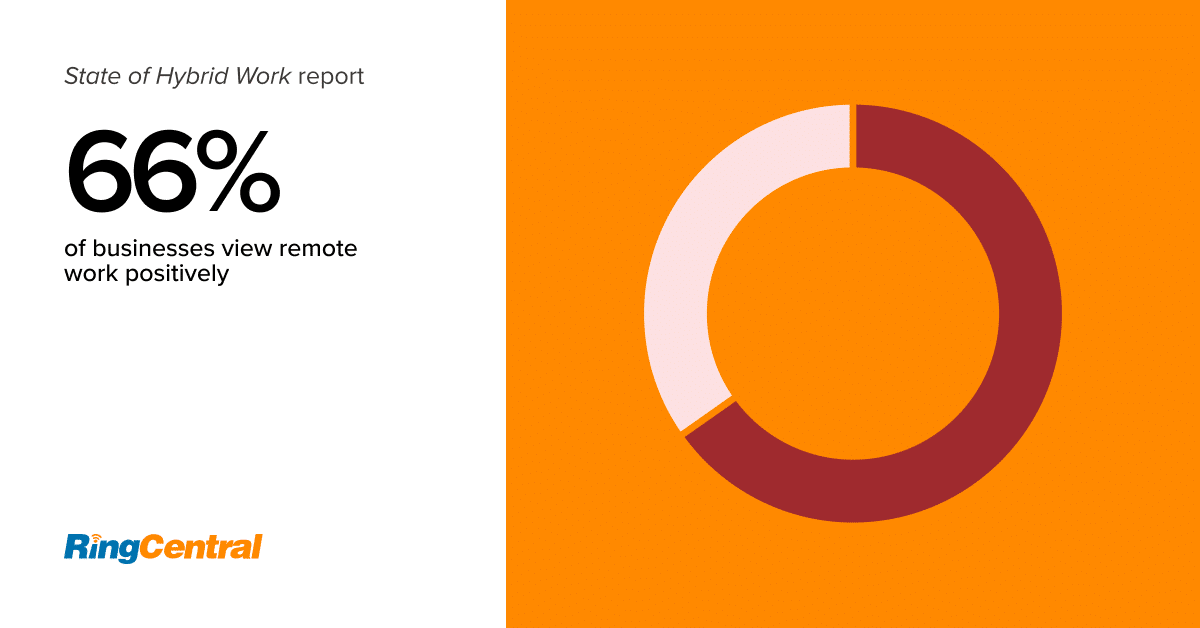Highlights:
- 66% of employees want flexible work options to remain. 1 in 3 are also ready to quit if “WFH” ends.
- Businesses are shifting to hybrid work, where employees split their time flexibly between the office and home.
- Success in a hybrid work environment will look very different than a fully remote or in-office one.
Change often comes slowly—and then all at once.
Take work for example. For generations, most people worked the typical 9 to 5. And while there was talk of remote work—and some slow adoption—through most of the last decade, it took a pandemic for it to become a norm overnight.
But the evolution of work isn’t nearly complete. As we move to the future, many companies will likely land somewhere between the office and remote, offering hybrid work arrangements for their employees.

Success in remote work
The adoption of remote work a year ago was fast, but it was also extremely successful. According to a recent PwC survey, 83% of employers gave high marks to their company’s remote experience over the last year—a 10% boost from initial sentiments about working remotely in the early months of lockdowns.

Both the research and anecdotal evidence show that employees were extremely productive. Although on the flip side, the blurring of home and office life can make it feel like we’re always on.
The improved scores over the course of 2020 reflect the nature of having to adapt to change overnight. Instead of being guided by a thought-out strategy, the rapid shift to remote work was more of an experiment that was refined and improved along the way.
The next frontier: hybrid work

As the pandemic winds down, we’re poised for yet another transition—to hybrid work.
According to Microsoft, 73% of employees want flexible work options to stay, and 66% of employers are considering new office designs that accommodate hybrid work. Google CEO Sundar Pichai officially announced their own return to work plan centered around a hybrid approach.
But at the other end of the spectrum, just a small percentage are prepared to let go of the office altogether. Although there is little consensus over the optimal split between working from home and the office, the majority agree that for many employees, work-life moving forward will consist of a combination of the two.
But unlike the rush to implement remote work, this next shift both allows for and demands greater planning, including an examination of some age-old workplace habits that have no place in a flexible, hybrid work era.
We’re definitely charting a new course. And while there will likely be some kinks to iron out, as a remote-first company, we at RingCentral have a good idea of what hybrid work requires to succeed. Here’s how we’re approaching this next monumental workplace transition.
1. Embrace open communication
At RingCentral, we see communication as the lifeblood of the organization, supporting almost everything we do.
The need to work together effectively and efficiently is true of most businesses—and it’s even more so for hybrid workplaces, where strong, ongoing communication practices act as a connector between employees working from home, the office and elsewhere.
Back in the office days, company communication was often top-down, with requests originating from upper management and working their way downward. But to support the needs of a flexible, hybrid organization, communication needs to be fluid and constant, with the tools and processes in place to support openness within and across all teams and functions.
2. Reconsider what the “workplace” means
When everyone worked from the office, work location meant a physical place. But hybrid work changes the definition of workplace. Although offices—and all of the meeting rooms and breakout spaces they offer—will remain a vital part of the equation, hybrid workplaces need to flex to include the virtual spaces where communication and collaboration also occur.
In considering where work gets done in a hybrid world, it’s not enough to consider office buildings alone. Companies also have to consider how they will build and support online collaboration space too. This includes bringing on solutions like RingCentral that allow workers to seamlessly message, meet and call from within a single app—and keep those communications organized and in context.
3. Extend flexibility to hours, not just location
The beauty of hybrid work is that it frees employees to perform various aspects of their jobs where it makes the most sense for them to do so. For example, one could prepare an in-depth sales deck from home and go into the office to present it to partners or prospective clients.
But to achieve their full potential, hybrid work models need to embrace flexible hours too. Google, Facebook, and Salesforce are among a growing number of companies that have said goodbye to 9 to 5. Why? Because not everyone does their best work—or can always be available—during regular office hours.
Although there are times when everyone on the team may need to be available at the same time, freeing night owls to burn the midnight oil or early birds to get a head start on the day allows employees to be their most productive and may improve job satisfaction.
4. Avoid micromanaging
Just as hybrid work means the end of using “time in seats” as a performance metric, it also needs to mark the end of peering over employees’ shoulders to make sure they’re getting work done. This isn’t because working from other locations can impede managers’ visibility into employees’ workdays. Micromanaging is simply a bad management practice that erodes trust and productivity.
Instead, consider that by taking care to support hybrid employees in doing their best work—including arming them with the tools and open flow of communication they need—workers will be better equipped to get their jobs done. At the end of the day, when managed effectively, the results will speak to the increased productivity and engagement hybrid work can provide.
The freedom to do your best work
There are exciting times ahead as businesses combine the best parts of office-based work and working from home into flexible, new hybrid models. But there’s no need to rush it.
We now have a lot of information to lean on about how to best support employees in new hybrid models. And while hybrid work will undoubtedly continue to evolve as we discover what works best for our unique teams, now is a good time to reevaluate old practices and explore the tools and processes that will drive the best results—wherever employees work from.
Looking For Startup Consultants ?
Call Pursho @ 0731-6725516
Telegram Group One Must Follow :
For Startups: https://t.me/daily_business_reads




